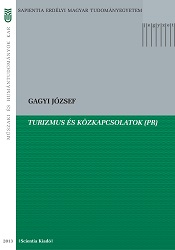Turizmus és közkapcsolatok (PR)
Tourism and Public Relations (PR)
Author(s): József Gagyi
Subject(s): Social Sciences, Communication studies
Published by: Scientia Kiadó
Keywords: tourism;public relations;communication
Summary/Abstract: The goal of these lecture notes, written for students majoring in Social Communication and Public Relations, is to present travel as a cultural form of behavior and tourism as a system of social communication. In my opinion, the subject of Tourism and Public Relations has the following task: to present the understanding of touristic phenomena and of society establishing itself and its relationships in the context of social and cultural sciences, and certain possible forms of their use in PR work. One has to imagine the situations of travel, of encountering the Alien or the Other, and then construct these for the tourism industry, i. e. establishing touristic travel services, composing destinations, constructing attractions, and public relations work. My lecture notes are aimed primarily towards future communications professionals who will develop heritage building and musealization, and based on these, establish touristic destinations and interpretations. Mediating between the tourist and the alien (this can be in the sense of cultural behavior, location, and individuals, equally), their task is to create and sustain the framework of the interpretation, to direct the processes of the production of meaning. My notes have an experimental character since they are not descriptions of actual practices, techniques, or applied methods, and they are not a collection of examples of PR tools used in the field of tourism. They are based on the assumption that the general knowledge of PR tools gained in the “Introduction to PR” lecture must be paired with the knowledge of the field it is applied in – tourism as a cultural practice. As a consequence, these lecture notes address the problems of tourism, the tourist, traveling and encounters, and specifically, those of destination, attraction, and interpretation. They also present examples, but in an attempt to establish a foundation, they concentrate more on discussing theoretical problems.
Series: Jegyzetek
- Print-ISBN-13: 978-973-197-076-9
- Page Count: 240
- Publication Year: 2013
- Language: Hungarian
- eBook-PDF
- Table of Content
- Introduction

